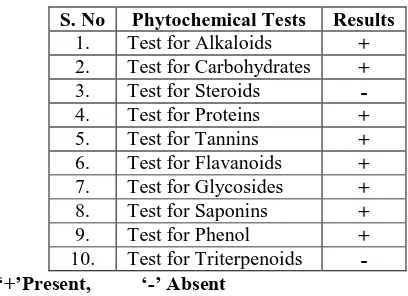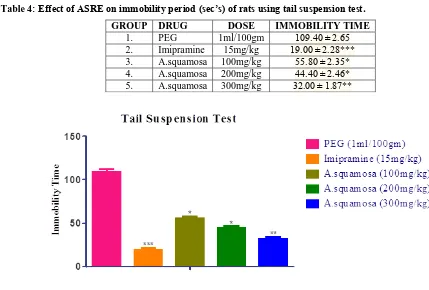Mahesh et al. World Journal of Pharmaceutical and Life Sciences
EVALUATION OF ANTI-DEPRESSANT ACTIVITY OF ETHANOLIC ROOT EXTRACT
OF ANNONA SQUAMOSA
L
Y. Anil Kumar1, T. Mahesh SSN*1, P. Kalpana1, T. Sai Aparna Tejaswini1 and Dr. Konda Ravi Kumar2
1
Department of Pharmacology, Hindu College of Pharmacy, Amaravathi Road, Guntur-522002. A.P, India.
2Professor, Department of Pharmaceutical Chemistry, Hindu College of Pharmacy, Amaravathi Road, Guntur-522002.
A.P, India.
Article Received on 10/04/2019 Article Revised on 30/04/2019 Article Accepted on 20/05/2019
INTRODUCTION
Annona squamosa L[1,2] is a species of the plant genus Annona, belongs to the family Annonaceae. The phytochemical analysis of Annona squamosa showed that it contained carbohydrates, alkaloids, flavonoids The preliminary pharmacological studies revealed that
Annona squamosa possessed analgesic
anti-inflammatory, antibacterial, cytotoxic, anti oxidant, antilipidimic, antiulcer, hypoglycemic, antidiabetic, hepatoprotective, insecticidal, anthelmintic and also used for the regulation of hyperthyroidism and lipid
peroxidation.[3,4] This study therefore, intends to
investigate the anti depressant activities of the roots of Annona squamosa L. by studying the effects of ethanol extracts of the plant on forced swim test and tail suspension test induced depression in experimental animal models, in order to confirm the medicinal properties of the plant. Depression, a state of low mood and aversion to activity, can affect a person's thoughts, behavior, tendencies, feelings, and sense of well-being. A multiple biological, psychological and social factors that have been identified as being related to the development of depression. Depression has been linked to problems or imbalances in the brain with regard
to the neurotransmitters serotonin, norepinephrine, and dopamine. Symptoms of the mood disorder is marked by
sadness, inactivity, difficulty in thinking and
concentration and a significant increase/decrease in appetite and time spent sleeping.[5,6] Antidepressants are commonly used in the treatment of anxiety and depression, medical conditions that affect 17–20% of the
population.[7] Many types of antidepressants are
available, they include Selective serotonin reuptake
inhibitors (SSRIs).Serotonin-nor epinephrine reuptake
inhibitors (SNRIs).A typical antidepressants, Tricyclic
antidepressants, Monoamine oxidase inhibitors
(MAOIs). Anti depressants by keeping the levels of the neurotransmitters higher improves communication between the nerve cells and which strengthens the circuits in the
brain which regulates mood. ECT (Electroconvulsive
Therapy) is an effective treatment for patients who do
not respond to drug therapy.[8,9]
Plant profile
Botanical Name: Annona squamosa.
World Journal of Pharmaceutical and Life Sciences
WJPLS
www.wjpls.org
SJIF Impact Factor: 5.088*Corresponding Author: T. Mahesh SSN
Department of Pharmacology, Hindu College of Pharmacy, Amaravathi Road, Guntur-522002. A.P, India.
ABSTRACT
This work has been done for the investigation of the anti-depressant activity of Ethanolic root extract of Annona squamosa (EREAS) belongs to the family Annonaceae by oral administration at dose according to the body weight in a sequential manner in healthy albino rats. Extracts were studied for its anti-depressant activity by using Imipramine as standard drug. Forced swim test (FST) and Tail suspension tests (TST) are used for the study. Imipramine decreases the immobility time of the animals. Plant extract given in three doses (100, 200 and 300mg/kg) were in a dose dependent manner. 300mg/kg plant extract showed decreased immobility time near as to that of the standard drug. The decrease in immobility period in both the models was observed starting from 200 mg/kg. But the increase in dose from 200 to 300 mg/kg produces further reduction in immobility period. At the dose 100 & 200mg/kg, ASRE showed a little antidepressant effect when comparable to that of Imipramine. At the dose 300 mg/kg, ASRE showed antidepressant effect which is comparable to that of Imipramine. This evaluation may suggest that the antidepressant action is because of the possible involvement of either nor-adrenergic or serotonergic system.
Classification
Kingdom : Plantae Superdivision : Spermatophyta
Division : Magnoliophyta Class : Magnoliopsida
Subclass : Magnoliidea Order : Magnoliales Family : Annonaceae Genus : Annona L.
Vernacular Names
Hindi : sarifa, sherifa, sitaphal.
Telugu : seetapandu, seethapandu, seethaphalam, sitapandu, sitaphalamu. English : custard apple, sweetsop.
Tamil : annila, atta, cintamaram.
Sanskrit : krishnabija, krisnabija, shubha, sitapalam, sitaphala.
Malayalam : atha, atta, sirpa, sirpha, sitapalam, sitappalam, sutakanni.[12]
Geographical Distribution
Annona squamosa is native to the tropical Americas and West Indies, but the exact origin is unknown. It is now the most widely cultivated of all the species of Annona, being grown for its fruit throughout the tropics and
warmer subtropics, such as Indonesia, Thailand,
and Taiwan; it was introduced to southern Asia before 1590. It is naturalized as far north as southern Florida in the United States and as south as Bahia in Brazil, and is an invasive species in some areas.
Medicinal uses
Strongly astringent
Used to treat diarrhoea and dysentery.
They have effective vermicidal properties.
To relieve cold and chills.
To lower uric acid levels in the blood.
Gastric purgative.
Used in a sedative infusion.
To aid digestion
To treat rheumatism.
For treatment of sleeplessness.
Excellent vermifuge.
METHODS AND MATERIALS
Plant material
The fresh plant of Annona squamosa L. roots were collected from Nandivelugu, Guntur, Andhra pradesh, India. The plant roots are dried under sunlight for one month and chopped into small pieces. The powdered plant was used for the preparation of ethanolic root extract.
Preparation of Ethanolic roots extract of Annona
squamosa by maceration Method
The plant material was dried under sun light and powdered mechanically. The 50 gm of powder sample was extracted with ethanol by using maceration method. The extraction was continued till a few drops of the last portion of the extract left no residue on drying. The solvent was removed by heat evaporation and dried under reduced pressure. The yield of the ethanol extract was 9.4%. The dried extract was stored in refrigerator until further studies.
Priliminary Phytochemical Analysis
Phytochemicals of the selected plants were carried out by using ethanolic and powdered form of the plant following Harborne (1973) Trease and Evans (1989).
Animals
Table 1: Phytochemical tests for constituents.
S. No Phytochemical Tests Results
1. Test for Alkaloids +
2. Test for Carbohydrates +
3. Test for Steroids -
4. Test for Proteins +
5. Test for Tannins +
6. Test for Flavanoids +
7. Test for Glycosides +
8. Test for Saponins +
9. Test for Phenol +
10. Test for Triterpenoids -
‘+’Present, ‘-’ Absent
All the animals were acclimatized to the laboratory environment 5 days prior to experiment. The animal were fasted overnight just prior to the experiment but allowed free access to drinking water.
Chemicals: Imipramine, PEG.
Grouping of Animals
Table 2: Grouping of animals based on dose.
Group Dose Dose and route of Drug Administration
I Control - treated with PEG According to the body wt.
II Standard drug: Imipramine 15 mg/kg
III Low dose of A.squamosa 100 mg/kg. p.o.
IV Mid dose of A.squamosa 200mg/kg, p.o.
V High dose of A.squamosa 300mg/kg, p.o
RESULTS AND DISCUSSION
Forced Swim Test (FST)
FST or behaviour despair was proposed as a model to test for antidepressant activity by Porsolt et al. Depression was produced by forcing the animal to swim individually in a glass jar containing fresh water of 15cm height and maintained at 25oC. This constituted pretest
session. Twenty-four hour later each animal was again forced to swim. After an initial 2 min period of vigorous activity, each animal assumed a typical immobile posture. The total duration of immobility was recorded in next 4 min of a total 6 min test. The change in the immobility period was calculated after administering drugs to the groups.
Table 3: Effect of ASRE on Immobility Period (Secs) of rats using Forced Swim Test.
GROUP DRUG DOSE IMMOBILITY TIME
1. PEG 1ml/100gm 120.60 ± 3.88
2. Imipramine 15mg/kg 28.00 ± 1.58***
3. A.squamosa 100mg/kg 60.60 ± 2.65*
4. A.squamosa 200mg/kg 45.60 ± 2.73*
5. A.squamosa 300mg/kg 31.40 ± 2.42**
Fig. 1: Forced swim test result analysis.
Tail Suspension Test (TST)
The total duration of immobility induced by tail suspension was measured according to the method
from the tip of the tail. Immobility time was recorded during a 6 min. period. Changes in the immobility duration were studied after administering drugs in separate groups of animals. The antidepressant activity
was expressed as reduction in the immobility duration between the control, standard and animals treated with test drug.
Table 4: Effect of ASRE on immobility period (sec’s) of rats using tail suspension test.
GROUP DRUG DOSE IMMOBILITY TIME
1. PEG 1ml/100gm 109.40 ± 2.65
2. Imipramine 15mg/kg 19.00 ± 2.28***
3. A.squamosa 100mg/kg 55.80 ± 2.35*
4. A.squamosa 200mg/kg 44.40 ± 2.46*
5. A.squamosa 300mg/kg 32.00 ± 1.87**
Fig. 2: Tail suspension test result analysis.
On the basis of the clinical association of depressive episodes and stressful life events, many of the animal models for the evaluation of antidepressant drug activity
assess stress precipitated behaviors. The two most
widely used animal models for antidepressant screening are the forced swimming and tail suspension tests. These tests are quite sensitive and relatively specific to all major classes of antidepressants. In TST, immobility reflects a state of despair which can be reduced by several agents which are therapeutically effective in human depression. Similarly in the FST, rats are forced to swim in restricted space from which they cannot escape. This induces a state of behavioral despair in animals, which is claimed to reproduce a condition similar to human depression. It has been seen that the TST is less stressful and has higher pharmacological sensitivity than FST. The present study was conducted for 14 days with administration of all the control, standard and test drugs to study the antidepressant activity. Results showed that the administration of the root extract of A. squamosa produced a diminution of immobility time in rats which were exposed to both forced swimming and tail suspension tests. In this study,
fresh roots of A. squamosa (100-300mg/kg) along with
imipramine 15mg/kg administered to rats, produced significant antidepressant like effect in both TST and FST when compared to control group.
Statistical analysis
Statistical significance was determined by analysis of variance. The analysis was performed using INSTAT statistical software.
CONCLUSION
The observation of acute toxicity study indicated that there was no death in 2000mg/kg dose after 72hrs. ASRE at the dose of 100 mg/kg had no beneficial effect on immobility period of rats in both the models of depression i.e. FST & TST. The decrease in immobility period in both the models was observed starting from 200 mg/kg. But the increase in dose from 200 to 300 mg/kg produces further reduction in immobility period. At the dose 100 & 200mg/kg, ASRE showed a little antidepressant effect when comparable to that of Imipramine. At the dose 300 mg/kg, ASRE showed antidepressant effect which is comparable to that of imipramine. This evaluation may suggest that the antidepressant action is because of the possible involvement of either nor-adrenergic or serotonergic system.
REFERENCES
1. https://en.wikipedia.org/wiki/Annona_squamosa.
2.
3. http://www.globalresearchonline.net/journalcontents /volume10issue2/Article-004.pdf.
4. https://www.researchgate.net/publication/306478912
_The_pharmacological_properties_of_Annona_squa mosa_Linn_A_Review.
5. https://en.wikipedia.org/wiki/Depression_(mood).
6.
https://www.mentalhelp.net/articles/biology-of-depression-neurotransmitters/.
7. https://www.ncbi.nlm.nih.gov/pmc/articles/PMC358
1018/.
8.
https://www.mayoclinic.org/diseases- conditions/depression/diagnosis-treatment/drc-20356013.
9.
https://www.webmd.com/depression/how-different-antidepressants-work#1.
10.

